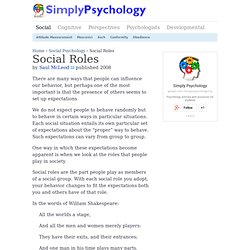

Milgram Experiment - The Milgram Obedience Experiment. By Kendra Cherry Updated December 16, 2015.

If a person in a position of authority ordered you to deliver a 400-volt electrical shock to another person, would you follow orders? Most people would answer this question with an adamant no, but Yale University psychologist Stanley Milgram conducted a series of obedience experiments during the 1960s that led to some surprising results. Social Roles and Social Norms. By Saul McLeod published 2008.

Conformity and obedience. SOCIAL INF NOTES. Milgram Experiment - The Milgram Obedience Experiment. The Shocking Truth of the Notorious Milgram Obedience Experiments - The Crux. By Gina Perry The original Milgram “shock box,” on display at the Ontario Science Centre.

Image by Isabelle Adam via Flickr It’s one of the most well-known psychology experiments in history – the 1961 tests in which social psychologist Stanley Milgram invited volunteers to take part in a study about memory and learning. Its actual aim, though, was to investigate obedience to authority – and Milgram reported that fully 65 percent of volunteers had repeatedly administered increasing electric shocks to a man they believed to be in severe pain. The Shocking Truth of the Notorious Milgram Obedience Experiments - The Crux. Milgram Obedience Experiment. What psychological experiment could be so powerful that simply taking part might change your view of yourself and human nature?

What experimental procedure could provoke some people to profuse sweating and trembling, leaving 10% extremely upset, while others broke into unexplained hysterical laughter? What finding could be so powerful that it sent many psychologists into frenzied rebuttals? Welcome to the sixth nomination for the top ten psychology studies and as you’ll have guessed it’s a big one. Hold on for controversy though, as this study has come in for considerable criticism with some saying its claims are wildly overblown. Explaining human cruelty. Milgram Experiment Ethics - Should We Use Deception in Experiments? In recent years, psychologists and social scientists have begun to question the Milgram experiment ethics, and whether the experiment should have been allowed at all.

This notorious experiment was designed as a response to the notorious trials of Nazi war criminals, who claimed that they were 'just following orders'. Milgram wanted to establish whether people really would obey authority figures, even when the instructions given were morally wrong. The main thing to remember, when judging the experiment is that modern day criticisms have the benefit of hindsight. A few decades ago, Europe had been mentally scarred by the atrocities committed during the Second World War, and was looking for answers.
Even a few years later, in the 1960s, these wounds remained; as a Jew himself, Milgram was trying to establish whether the claim of war-criminals, that they were just obeying orders, was a reasonable defense or not. We would love feedback on this article. Suggest changes. Asch Experiment - Conformity in Groups. The Asch Experiment, by Solomon Asch, was a famous experiment designed to test how peer pressure to conform would influence the judgment and individuality of a test subject.

The experiment is related closely to the Stanford Prison and Milgram Experiments, in that it tries to show how perfectly normal human beings can be pressured into unusual behavior by authority figures, or by the consensus of opinion around them. For the experiment, eight subjects were seated around a table, with the seating plan carefully constructed to prevent any suspicion.
Only one participant was actually a genuine subject for the experiment, the rest being confederates, carefully tutored to give certain pre-selected responses. Careful experimental construction placed a varying amount of peer pressure on the individual test subject. The Lucifer Effect by Philip Zimbardo. Discover Magazine April, 2007View article (PDF) In August of 1971, social psychologist Philip Zimbardo performed an infamous experiment at Stanford University, one whose results still send a shudder down the spine because of what they reveal about the dark side of human nature.

In The Lucifer Effect: Understanding How Good People Turn Evil (Random House, $27.95), Zimbardo recalls the Stanford Prison Experiment in cinematic detail. We watch as nice, middle-class young men turn sadistic; the experiment is terminated prematurely due to its characterimploding power. These events shaped the rest of Zimbardo’s career, focusing him on the psychology of evil, including violence, torture, and terrorism. 5 Horrific Psychological Experiments – #1: The Milgram Experiment.
Back in 1961 at Yale University, a young psychologist named Stanley Milgram devised an ingenious experiment that managed to demonstrate just how utterly lost any hope is for humanity.

The Milgram Experiment was above the board in all scientific respects, but as far revealing horror goes, it destroys all comers. To get to the bottom of how malleable human conscience is in the face of authority, Milgram recruited nice, salt-of-the-earth, God-fearing New Haven, Conn., residents and asked them to serve as “teachers” in what he told them was a study to determine how negative reinforcement improves memory. The negative reinforcement in this case was a nasty little electric shock delivered anytime a “student” got an answer wrong. 5 Horrific Psychological Experiments – #2: Stanford Prison Experiment. There’s a very dark core located somewhere deep within each of us.

For, say, Henry Lee Lucas, it was much closer to the surface. For Shirley Temple, perhaps a little more repressed (although there was the one unpleasant incident no one talks about with the drifter). The Stanford Prison Experiment - Overview of the Stanford Prison Experiment. In 1971, psychologist Philip Zimbardo and his colleagues set out to create an experiment that looked at the impact of becoming a prisoner or prison guard.

Zimbardo, a former classmate of Stanley Milgram (who is best-known for his famous obedience experiment, was interested in expanding upon Milgram's research. He wanted to further investigate the the impact of situational variables on human behavior. The question the researchers asked was how would the participants react when placed in a simulated prison environment. "Suppose you had only kids who were normally healthy, psychologically and physically, and they knew they would be going into a prison-like environment and that some of their civil rights would be sacrificed.
Would those good people, put in that bad, evil place—would their goodness triumph? " Zimbardo - Stanford Prison Experiment. 1) Majority Influence. Social influence is the term used to describe how the behaviour of one person affects the behaviour of another. Majority Influence is when the behaviour of a large number of people affects the behaviour of a smaller group of people. This normally results in conformity, this is the change in someone’s behaviour due to influence of others.
There are three types of conformity: 1) Compliance – going along with others to gain their approval 2) Internalisation – going along with others because you have accepted their opinions and believe them too 3) Identification – going along with others because you accepted their opinions, but only because you want to be like them Research Asch (1956) 2) Minority Influence. It’s not just majority influence that people conform to; minority influence can also cause a change in people’s behaviour and beliefs.
Minority influence is when a small number of people affect a larger number. This can clearly be seen throughout history, for example in the 1970s activists for caring for the environment were dismissed as “hippies”, but now, thanks to minority influence, it is now then norm to be concerned about global warming. Research Moscovici et al (1969) 2) Minority Influence. 3) Explanations of why people conform. There are three main reasons as to why people conform, normative social influence, informational social influnece and social impact theory.
Normative social influence This type of social influence is associated most commonly with compliance (going along with the majority even if you don’t accept their beliefs because you want to be accepted). Normative social influence is when a majority are able to control other groups by exerting pressure on them to conform. Because the majority normally have the greatest power they can do this very easily. For example, the majority could make the minority feel uncomfortable about disagreeing, as we see in Asch’s study. 4) What is obedience, and why do we obey? Obedience is complying with someone’s wishes or demand because of their power. Often in life we are faced with a decision of whether to obey or disobey, and psychologist are interested to see why, especially why people obey when the consequences will clearly be negative. 5) Resisting Social Influence. 6) Individual Differences and how it causes Independant Behaviour.
6) Individual Differences and how it causes Independant Behaviour. Level Psychology Social Influence Revision - S-Cool Revision Summary.